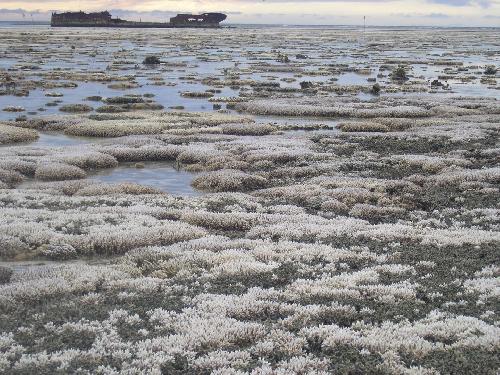HOUSTON -- (Feb. 17, 2016) -- A study by biologists from Rice University and Oregon State University has found that significant outbreaks of marine viruses may be associated with coral bleaching events, especially as a result of multiple environmental stresses.
The new findings in the journal Frontiers in Microbiology document a viral outbreak that occurred as corals were bleaching -- losing color as a byproduct of expelling symbiotic algae that live in the corals' tissues -- in part of the Great Barrier Reef off the east coast of Australia. Researchers who studied the reef with support from the National Science Foundation found three viral groups, including a herpes-like virus, in the outbreak.
The loss of sugars donated by the algae -- the major food source for corals -- can leave corals more susceptible to disease or being overgrown by reef competitors. In severe or prolonged cases, bleaching can be lethal to corals.
 A section of the Great Barrier Reef off the east coast of Australia underwent bleaching in early 2011. Researchers found that a viral outbreak coincided with the bleaching. Credit: A.M.S. Correa/Rice University
A section of the Great Barrier Reef off the east coast of Australia underwent bleaching in early 2011. Researchers found that a viral outbreak coincided with the bleaching. Credit: A.M.S. Correa/Rice University
"It is well established that bleaching can occur if environmental stress, such as unusually high temperatures, makes the photosynthetic machinery in symbiotic algae go haywire," said study lead author Adrienne Simoes Correa, a marine biologist in Rice's Department of BioSciences. "During this particular event, we saw conditions get tough for coral colonies, then the reef bleached and we observed very high abundances of several kinds of viruses in these corals, all within a period of a few days."
Correa said it's possible that viral infection of corals' symbiotic algae may have contributed to the bleaching in these colonies.
"If true, that would open up a whole new way to think about bleaching," Correa said.
The study's authors said the research is especially significant because Earth is now experiencing just the third recorded incidence of mass coral bleaching on a global scale.
"People all over the world are concerned about long-term coral survival," said study corresponding author Rebecca Vega-Thurber, an assistant professor of microbiology in Oregon State's College of Science. "This research suggests that viral infection could be an important part of the problem that until now has been undocumented and has received very little attention."
While viruses are abundant, normal and diverse residents of stony coral colonies, they can become a serious threat to corals when their numbers reach extremely high levels. In the new study, researchers observed a coral reef near Heron Island on the Great Barrier Reef in 2011 as it was exposed to multiple stresses from high levels of ultraviolet light at low tides during a period of heavy rain and high temperatures. During the period of observation, researchers found that viral loads in the corals exploded to levels two to four times higher than any previously recorded, and a significant bleaching event occurred at the same time as the viral outbreak.
The viruses included retroviruses, megaviruses and a type of herpes virus, which was particularly abundant. Herpes viruses are ancient and are found in a wide range of mammals, marine invertebrates, oysters, corals and other animals.
Vega-Thurber said the findings suggest that a range of stresses, particularly high water temperatures such as those that can be caused by an El Nino event and global warming, may have made the corals susceptible to viral attack.
"This is bad news," Vega-Thurber said. "This bleaching event occurred in a very short period on a pristine reef. It may recover, but incidents like this are now happening more widely all around the world."
Last year, the National Oceanic and Atmospheric Administration (NOAA) declared that the world is now experiencing its third global coral-bleaching event, the last two being in 1998 and 2010. The latest global bleaching event began in the northern Pacific Ocean in 2014, moved south in 2015 and may continue into this year, NOAA officials said. NOAA estimated that by the end of last year, almost 95 percent of U.S. coral reefs were exposed to ocean conditions that can cause corals to bleach.
"Coral reefs around the world are in trouble because human actions have abnormally warmed seas, polluted reefs with nutrients and killed off the fish that used to eat coral-smothering algae," Correa said. She said the viral outbreak in the latest study was linked with exposure to air and heavy rainfall at low tide, but it's possible that other types of stress could foster the same sort of outbreaks.
"We need to get back out on the reef and determine whether massive viral infections also occur in direct response to fertilizer runoff and other land-based nutrient pollution," Correa said. "We have a special chance to tackle this question right now in terms of high-temperature stress, given the ongoing global bleaching event."
source: Rice University